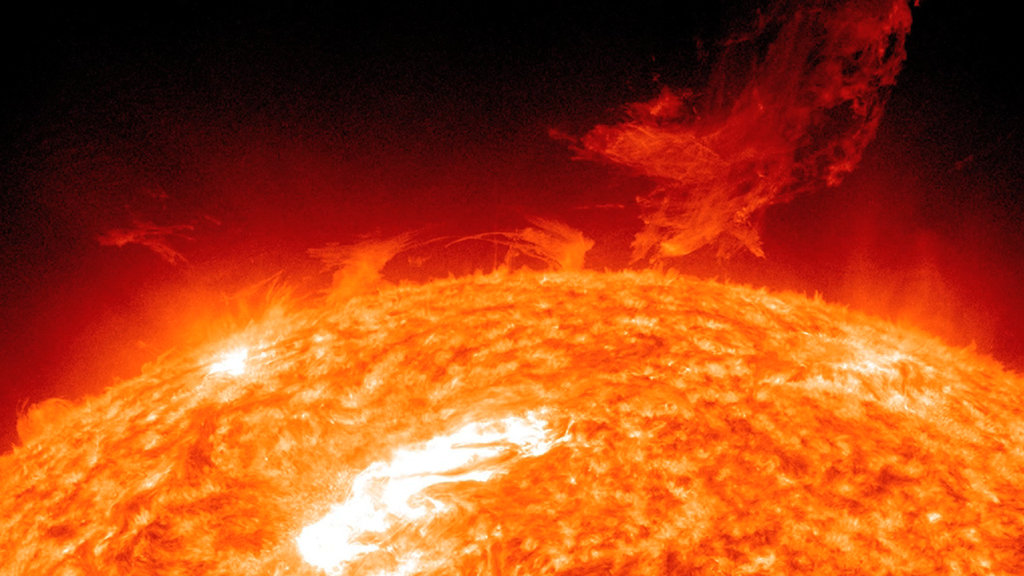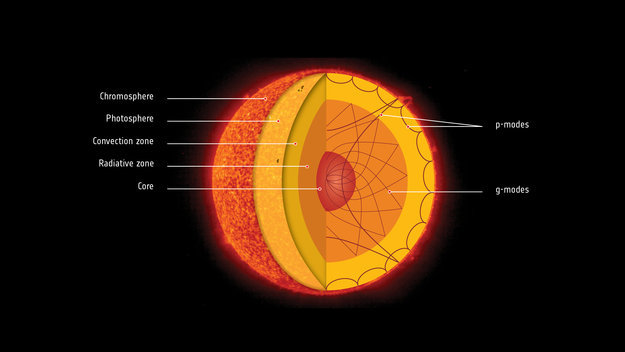The Sun's Core Rotates Four Times Faster Than the Solar Surface

For several years, solar scientists have been able to detect a certain kind of seismic wave — called pressure waves or p-waves — traveling across the surface of the sun. However, they also knew another type of seismic wave must travel deep within the sun, but these waves — called gravity waves or g-waves — eluded detection.
After decades of looking — and listening — scientists using the Solar and Heliospheric Observatory, or SOHO, were finally able to detect the low-frequency g-waves. And in identifying them, they found a surprise: The sun's core is rotating up to four times faster than the solar surface.
"The solar oscillations studied so far are all sound waves, but there should also be gravity waves in the sun, with up-and-down, as well as horizontal motions, like waves in the sea," astronomer Eric Fossat from the Côte d'Azur Observatory said in a statement. Fossat is the lead author of a new paper about the detection, published in Astronomy & Astrophysics. "We've been searching for these elusive g-waves in our sun for over 40 years, and although earlier attempts have hinted at detections, none were definitive. Finally, we have discovered how to unambiguously extract their signature."

Fossat and his team were able to make the detection using helioseismology. Similar to how seismologists study Earth's interior by listening to how the seismic waves that cause earthquakes travel through rock layers, solar physicists can listen and track oscillations in the sun to see how waves propagate throughout the star.
Helioseismology, which could be considered a type of acoustical spectroscopy, has given scientists the ability to measure the invisible internal structure and dynamics of our sun. Different oscillation modes operate at different depths inside the star, so combining the rate and amplitude of the oscillations can reveal the composition and internal configuration.
But unlike Earth, where seismic events typically happen one at a time, the team said the sun is continuously "ringing" from sounds waves due to the continuous convection of solar material churning both on — and beneath — the surface, making it difficult to pick out certain low frequencies.
Stellar oscillations are divided into three categories, based on the force that drives them: pressure, surface-gravity, and gravity wave modes. The p-waves have pressure as their force, and can tell us things about the structure and density of regions just below the surface of a star. Surface gravity waves, or f-modes, occur at — or near — the outer layers of stars, so they give us information about the surface conditions of stars.
Get the Space.com Newsletter
Breaking space news, the latest updates on rocket launches, skywatching events and more!
RELATED: A Dying Star's Explosive 'Fireball' Blast Aimed a Beam of Gamma Rays at Earth
Gravity waves, or g-waves, are confined to the interior of a star. They represent oscillations of the deep solar interior that have no clear signature at the surface. They also are at a lower frequency and therefore have been a challenge to detect directly.
Gravity waves are not the same as gravitational waves, which were detected by the LIGO (Laser Interferometer Gravitational-Wave Observatory) team. Gravitational waves are perturbations across space-time at universal scales, while gravity waves are perturbations within solar bodies or planetary atmospheres at smaller scales.
"Over the past 40 years, helioseismology has been enormously successful in the study of the solar interior," the team wrote in their paper. "A shortcoming has been the lack of a convincing detection of the solar g modes, which are oscillations driven by gravity and are hidden in the deepest part of the solar body – its hydrogen-burning core. The detection of g-modes is expected to dramatically improve our ability to model this core, the rotational characteristics of which have, until now, remained unknown."
The team used over 16 years of data collected by SOHO, which has been in space since 1995. In particular, they used data from SOHO's Global Oscillations at Low Frequencies, or GOLF, instrument, which was built to measure oscillations within the sun in a certain frequency range (10-7 to 10-2 Hz.)
The search for g-waves in GOLF measurements has been extremely difficult because of solar and instrumental noise. So they tried a different approach: They looked at all the frequency modulations produced by the sun and figured out how to detect the imprint of the g-waves, which usually ride along with the more easily detected p-waves. They looked at a p-wave parameter that measures how long it takes for an acoustic wave to travel through the sun and back to the surface again, which is known to take four hours and seven minutes. Using various analytical and statistical techniques, they picked out a series of modulations within the p-mode parameter, which they determined was the elusive and very low frequency signature of g-waves pulsating from the structure of the Sun's core.
RELATED: The Great American Solar Eclipse: Here's Everything You Need to Know
The signature of the g-waves suggests that the solar core is rotating once every week, which is nearly four times faster than the sun's surface and intermediate layers, which have rotation rates at about 25 days at the equator to 35 days at the poles.

"The most likely explanation is that this core rotation is left over from the period when the sun formed, some 4.6 billion years ago," said Roger Ulrich, from UCLA and co-author of the study. "It's a surprise, and exciting to think we might have uncovered a relic of what the sun was like when it first formed."
What can be learned from knowing the rotation rate of the core of the sun? It might provide clues as to how the sun formed and how features form on the sun today, such as sunspots. But Ulrich and Fossat both said the first detection of g-waves now opens up new questions for solar physicists to study, such as how the different layers of the sun interact — even though they are all rotating differently — and learning more about the composition of the core based on its rotation.
"G-modes have been detected in other stars, and now thanks to SOHO we have finally found convincing proof of them in our own star," Fossat said. "It is really special to see into the core of our own sun to get a first indirect measurement of its rotation speed. But, even though this decades-long search is over, a new window of solar physics now begins."
Originally published on Seeker.
Join our Space Forums to keep talking space on the latest missions, night sky and more! And if you have a news tip, correction or comment, let us know at: community@space.com.

Nancy Atkinson is a science journalist and author who works to tell the stories of people involved in space exploration and astronomy. She has written two books about the people behind NASA projects like the Apollo missions and the robotic rovers exploring our solar system, and hosted/worked on several astronomy podcasts. A writer for Universe Today since 2004, Atkinson's work can also be found at The Planetary Society and Ad Astra, the magazine of the National Space Society. Other work can be found at Seeker, New Scientist, Wired.com, Space.com, NASA’s Astrobiology Magazine, Space Times Magazine, and several newspapers in the Midwest.
